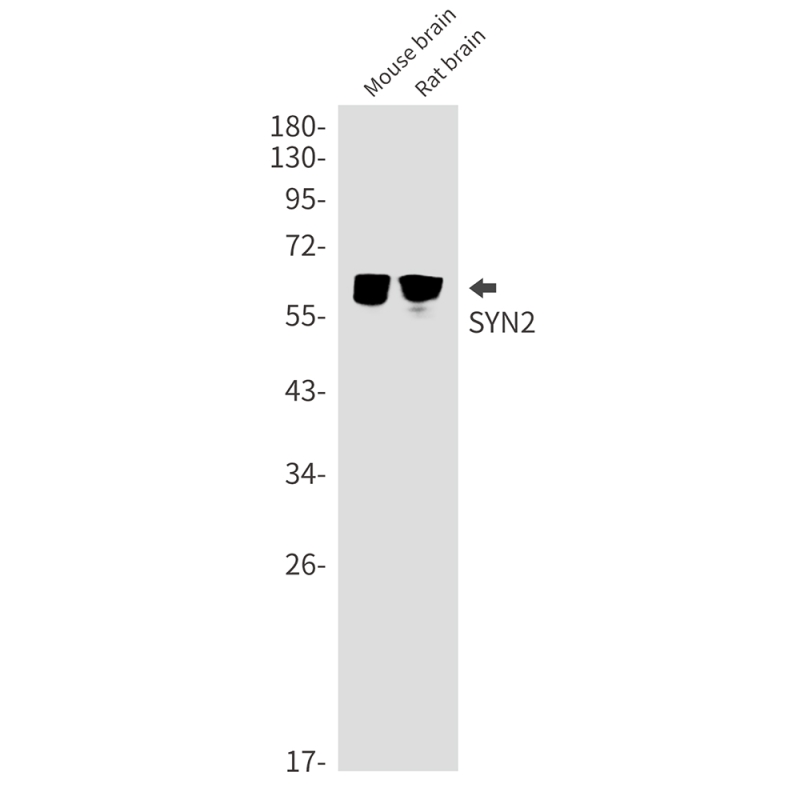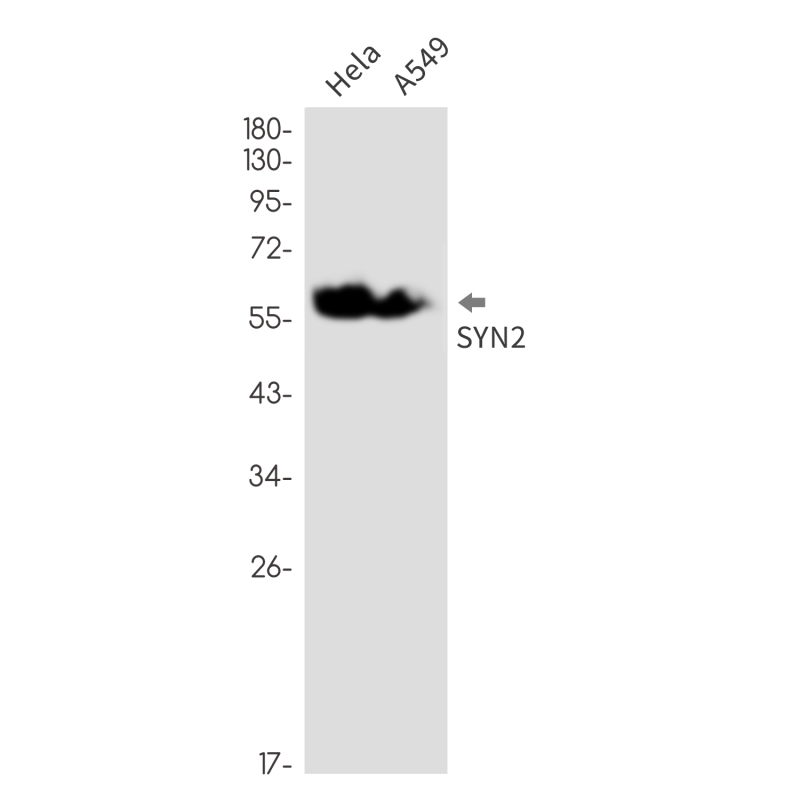


| WB | 1/500-1/1000 | Human,Mouse,Rat |
| IF | 咨询技术 | Human,Mouse,Rat |
| IHC | 1/50-1/100 | Human,Mouse,Rat |
| ICC | 技术咨询 | Human,Mouse,Rat |
| FCM | 咨询技术 | Human,Mouse,Rat |
| Elisa | 咨询技术 | Human,Mouse,Rat |
| Aliases | SYN 2; SYN II; SYN IIa; SYN IIb; SYN2; Synapsin2; SynapsinII; SYNII; SYNIIa; SYNIIb |
| Entrez GeneID | 6854 |
| WB Predicted band size | Calculated MW: 63 kDa; Observed MW: 63 kDa |
| Host/Isotype | Rabbit IgG |
| Antibody Type | Primary antibody |
| Storage | Store at 4°C short term. Aliquot and store at -20°C long term. Avoid freeze/thaw cycles. |
| Species Reactivity | Human,Mouse,Rat |
| Immunogen | A synthetic peptide of human SYN2 |
| Formulation | Purified antibody in TBS with 0.05% sodium azide,0.05%BSA and 50% glycerol. |
+ +
以下是关于Synapsin 2抗体的3篇代表性文献,涵盖抗体开发、功能研究及疾病应用:
---
1. **文献名称**:*Synapsin I and II: Differential regulation by phosphorylation in nerve terminals*
**作者**:Südhof, T.C. 等
**摘要**:该研究系统分析了Synapsin I和II在神经元中的功能差异,开发了特异性抗体用于区分两种亚型。通过免疫沉淀和免疫荧光验证抗体特异性,发现两者在突触囊泡锚定和神经递质释放中具有不同调控机制。
---
2. **文献名称**:*Synapsin II knockout mice exhibit enhanced hippocampal plasticity and epileptic susceptibility*
**作者**:Kao, H.Y. 等 (2016)
**摘要**:利用Synapsin 2抗体检测基因敲除小鼠脑组织中的蛋白表达缺失,结合电生理和行为学实验,发现Synapsin 2缺失导致海马突触可塑性异常升高,并增加癫痫易感性,提示其维持突触稳态的作用。
---
3. **文献名称**:*Validation of commercial antibodies for selective detection of Synapsin II isoforms in neurodegenerative models*
**作者**:Bogen, I.L. 等 (2008)
**摘要**:评估多种商业Synapsin 2抗体的特异性,通过Western blot和免疫组化对比野生型与Synapsin 2敲除小鼠脑组织,筛选出高特异性抗体,并应用于阿尔茨海默病模型中发现其表达与突触损伤相关。
---
**备注**:若需获取全文或更多文献,建议通过PubMed或Google Scholar搜索关键词“Synapsin 2 antibody validation”或“Synapsin 2 immunohistochemistry”,可筛选近年方法学或疾病相关研究。
Synapsin 2 is a member of the synapsin family, a group of neuron-specific phosphoproteins primarily associated with synaptic vesicles. These proteins play critical roles in regulating synaptic transmission by modulating the availability of synaptic vesicles for neurotransmitter release. Synapsin 2. encoded by the SYN2 gene, is involved in vesicle trafficking, clustering, and tethering to the cytoskeleton, influencing synaptic plasticity and neuronal connectivity. Its function is dynamically regulated by phosphorylation during synaptic activity.
Antibodies targeting Synapsin 2 are essential tools in neuroscience research, enabling the detection and localization of the protein in brain tissues or cultured neurons. These antibodies are widely used in techniques like Western blotting, immunohistochemistry, and immunofluorescence to study synaptic architecture, neuronal development, and disease mechanisms. Specificity is crucial, as Synapsin 2 shares structural homology with other synapsin isoforms (Synapsin 1 and 3). Well-validated antibodies typically recognize unique epitopes within Synapsin 2’s conserved N-terminal domain or variable C-terminal regions.
Research employing Synapsin 2 antibodies has linked the protein to neuropsychiatric disorders, including schizophrenia and epilepsy, highlighting its role in synaptic dysfunction. Such studies often utilize knockout models or phosphorylation-specific antibodies to explore activity-dependent changes. Commercial Synapsin 2 antibodies are commonly raised in rabbits or mice, with monoclonal and polyclonal variants offering distinct advantages in sensitivity and specificity for experimental workflows.
×